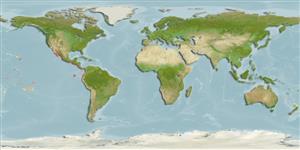>
Carangiformes (Jacks) >
Carangidae (Jacks and pompanos) > Trachinotinae
Etymology: Trachinotus: Greek, trachys, -eia, -ys = rough + Greek,noton = back (Ref. 45335).
More on author: Gill.
Environment: milieu / climate zone / depth range / distribution range
Écologie
marin récifal. Subtropical
Eastern Pacific: Zuma Beach in southern California, USA to Peru, including the Galapagos Islands.
Taille / Poids / Âge
Maturity: Lm ? range ? - ? cm
Max length : 61.0 cm TL mâle / non sexé; (Ref. 2850); common length : 25.0 cm TL mâle / non sexé; (Ref. 55763); poids max. publié: 1.3 kg (Ref. 40637)
Description synthétique
Clés d'identification | Morphologie | Morphométrie
Body deep (becoming deeper with age) and compressed; mouth small; jaw teeth small, villiform, and only slightly hooked; decreasing in number with age but always present; lower branch of first gill arch with 13 to 15 gill rakers; dorsal fin with 6 spines followed by another spine and 19 to 21 soft rays (VI+I, 19-21); anterior lobes of the second dorsal and anal fins elongated; body silvery with 4 to 6 pale yellow vertical bars that become dark after death; dorsal, anal, and caudal fins yellowish (Ref. 55763).
Adults inhabit inshore sandy areas and also clear waters around reefs and rocky areas (Ref. 9283). They feed on small invertebrates and fishes (Ref. 9283). Marketed fresh and salted or dried (Ref. 9283).
Life cycle and mating behavior
Maturité | Reproduction | Frai | Œufs | Fécondité | Larves
Eschmeyer, W.N., E.S. Herald and H. Hammann, 1983. A field guide to Pacific coast fishes of North America. Boston (MA, USA): Houghton Mifflin Company. xii+336 p. (Ref. 2850)
Statut dans la liste rouge de l'IUCN (Ref. 130435: Version 2024-1)
Menace pour l'homme
Harmless
Utilisations par l'homme
Pêcheries: intérêt commercial mineur; pêche sportive: oui
Outils
Articles particuliers
Télécharger en XML
Sources Internet
Estimates based on models
Preferred temperature (Ref.
123201): 20.3 - 29.1, mean 25.1 °C (based on 269 cells).
Phylogenetic diversity index (Ref.
82804): PD
50 = 0.5000 [Uniqueness, from 0.5 = low to 2.0 = high].
Bayesian length-weight: a=0.01122 (0.00514 - 0.02450), b=3.04 (2.87 - 3.21), in cm total length, based on all LWR estimates for this body shape (Ref.
93245).
Niveau trophique (Ref.
69278): 4.0 ±0.61 se; based on food items.
Résilience (Ref.
120179): Milieu, temps minimum de doublement de population : 1,4 à 4,4 années (Preliminary K or Fecundity.).
Fishing Vulnerability (Ref.
59153): Moderate vulnerability (44 of 100).
Nutrients (Ref.
124155): Calcium = 31.8 [13.3, 56.1] mg/100g; Iron = 0.711 [0.381, 1.332] mg/100g; Protein = 20.6 [18.5, 22.6] %; Omega3 = 0.223 [0.136, 0.373] g/100g; Selenium = 16 [8, 32] μg/100g; VitaminA = 33 [11, 103] μg/100g; Zinc = 0.611 [0.409, 0.924] mg/100g (wet weight);
